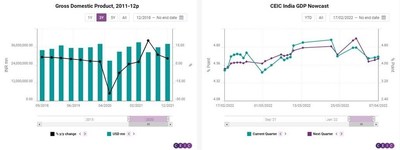
CEIC Logo
India’s GDP increased in real terms by 5.4% y/y in Q4 2021 (Q3 FY2022), the growth decelerating from 8.5% y/y in Q3 2021. CEIC’s proprietary GDP nowcast projected a growth of 5.6% y/y for Q4 2021, closer to the actual figure than RBI’s projection of 5.8% y/y.
MUMBAI, India, April 11, 2022 /PRNewswire/ — In today’s data-driven world, quarterly indicators like GDP are not enough, while traditional high-frequency indicators provide fragmentary signals for the state of the economy. Hence, the GDP nowcast models have been gaining popularity as this alternative data provides a real-time estimate of the economy, making it a preferred tool for decision making and timely analysis.
At its core lies a dataset of high-frequency indicators covering various sectors of the economy such as industry, consumption, financial, and services. For each of these indicators, their impact on the GDP Nowcast is calculated once new data is released in order to identify the driving factors of the GDP performance for the respective quarter in real time.
- The GDP Nowcast dataset contains real-time data on the “nowcasted” annual GDP growth for the current quarter and the impact of the release of each of the high-frequency underlying indicators on it
- The underlying high-frequency indicators are grouped in seven categories – industry, consumption, transportation, external trade, financial, prices, and others
- The real-time GDP Nowcast is updated every time when new data for the underlying high-frequency indicators is released, depending on their impact
- Monthly estimates reflect the impact of each underlying high-frequency indicator and its categories on the GDP Nowcast for the respective month
In the aftermath of the COVID-19 pandemic in Q1 FY2021, the Indian economy underwent its largest contraction on record. In addition to the restrictions on movement and economic activity across the nation, data collection and subsequent data releases also got impacted, which led to greater uncertainty regarding the effect of the lockdown on the economy. In such a situation, nowcasting models, which provide real-time estimates of the GDP based on high-frequency indicators, prove to be an excellent tool to monitor the economy. The relevance for GDP nowcast models is expected to grow even further given the uncertain times the world lives in, be it the Russia-Ukraine war or a lingering threat of newer variants and fresh waves of COVID-19.
Another proprietary indicator developed by CEIC is the CEIC Leading Indicator, that can be used in conjunction with the nowcasting model, which provides a more futuristic outlook of the economy. The smoothed CEIC leading indicator for India, has followed an upward trend since July 2021, climbing to 111.4 in January 2022 from 109.64 in December. This is the highest the indicator has ever been since the end of 2010, when it was above the 111-mark. While the dip in the non-smoothed indicator, to 111.17 in January from 113.69 in December, captures the impact of the third wave of the COVID-19, which led to renewed restrictions across parts of the country, the continued rise in the smoothed indicator suggests a strong underlying recovery of economic activity.
CEIC’s GDP nowcast growth of 4.7% y/y for Q4 FY2022, and 4.3% y/y for Q1 FY2023 as on April 7, 2022.
Related Links : https://info.ceicdata.com/en-products-india-premium-database
Photo: https://mma.prnewswire.com/media/1794208/CEIC_India_GDP_Nowcast.jpg
Logo: https://mma.prnewswire.com/media/1794207/CEIC_Logo.jpg

Disclaimer: The above press release comes to you under an arrangement with PRNewswire India and this publication takes no editorial responsibility for the same)







